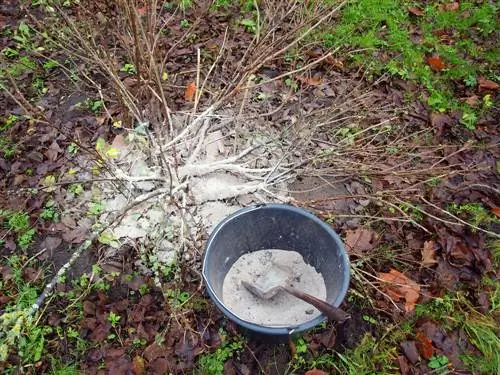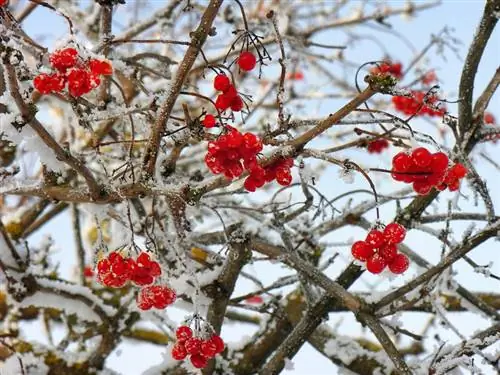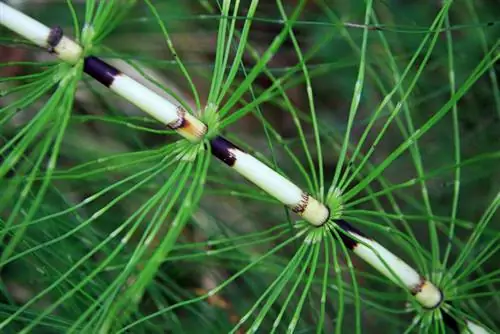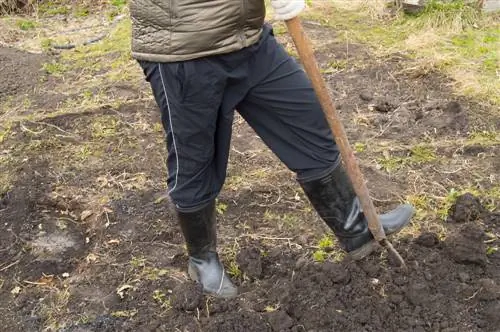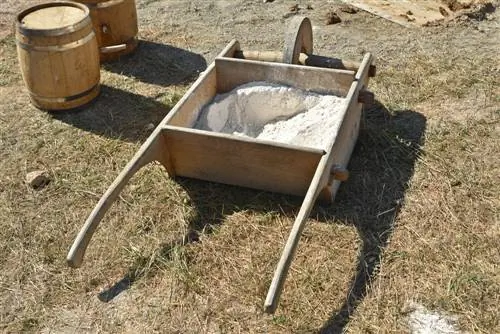- Author admin [email protected].
- Public 2023-12-16 16:46.
- Last modified 2025-01-23 11:22.
It makes sense to spread the ashes from the oven in your own garden. This reduces waste and the natural product ash takes on another meaning. In order for it to be considered a natural product, various requirements must be met.
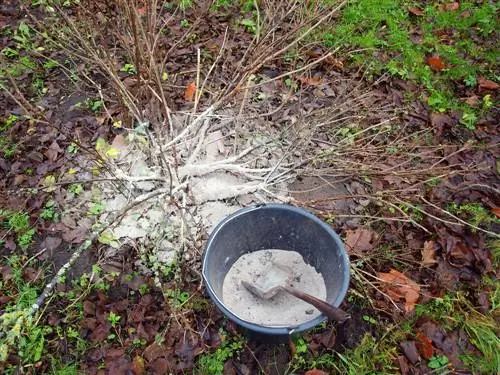
Can I use ash as fertilizer in the garden?
Ash is suitable as a fertilizer if it comes from pure wood and does not contain any heavy metals. It is rich in lime, potassium, iron and phosphate and is particularly suitable for plants that prefer calcareous soils. Ash has an alkaline effect and should be applied in small quantities to avoid damaging the soil and plants.
Is ash suitable as fertilizer?
Ash is a natural fertilizer that is easy to produce. Any hobby gardener can make it with a wood or fireplace stove. Ash is rich in lime and potassium. It also contains iron and phosphate, which are essential for he althy and strong plant growth. Ash fertilizer is mainly used for liming acidic soils. Since ash with a pH value between 11.0 and 13.0 has a strongly alkaline effect, it should not be used without restriction for all plants.
Wood ash contains:
- 25 to 45 percent quicklime (calcium oxide)
- three to six percent magnesium and potassium oxide
- two to six percent phosphorus pentoxide
- mineral trace elements (iron, manganese, boron and sodium)

Which ashes can I use?
Not all ash should be used to fertilize plants. Fireplace ash made from wood or burned charcoal is suitable, but here too you should know exactly the origin of the wood. Both hardwoods and softwoods are processed into charcoal. This can be charged differently depending on the source.
Excursus
Charcoal
The solid fuel is created when air-dried wood is heated strongly in the absence of oxygen. In various phases of heating, gases escape and ultimately carbonization occurs. These processes reach temperatures between 150 and 500 degrees Celsius. Good charcoal has a black shine, although the structure of the wood is still clearly visible. Poorly charred coals, on the other hand, have a red to brown-red color. When producing these so-called red coals, temperatures do not exceed 300 degrees Celsius.
You should pay attention to this
When burning additives in wood, harmful substances can be created and remain in the ash, which poison the soil. It may contain dioxin or other toxic substances. If the wood comes from an industrial region or near a highway, it may be contaminated with heavy metals.
How to make perfect wood ash:
- burn untreated and natural wood
- Use wood without varnishes and glazes
- Use dry branches, leaves or nut shells for lighting
Do not use colorfully printed newspaper for lighting as this contains chemical substances and can contaminate the ashes. Even black and white newspaper, egg cartons or toilet paper rolls should not be used. The material is often made from recycled paper, which can be contaminated with mineral oil components from colorful brochures. Also be careful not to mix wood ash with coal ash.
Inappropriate ash
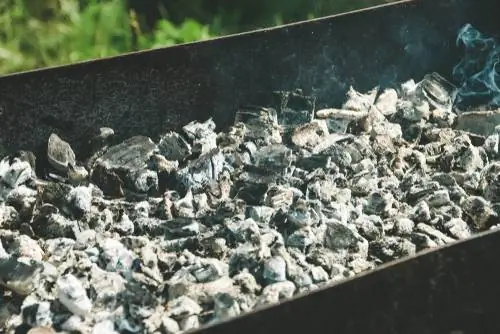
Ash from coal briquettes should not be used as fertilizer
Depending on the origin of the wood, the ash can contain harmful heavy metals that also poison the soil and plants. Lead, cadmium or chromium are often detectable in critical concentrations. Ash, which is produced from lignite and hard coal or coal briquettes, is also not suitable as a natural fertilizer due to the contamination with heavy metals.
Heavy metals are naturally contained in wood because the tree absorbs substances from the environment as it grows. The toxic metals also come from tool wear during production by logging machines.
To be on the safe side, you should dispose of the residue from burnt charcoal with household waste, as the origin is often unknown. In addition, ashes from the grill contain fat residues that were created during burning. Degradation products such as acrylamide are harmful to he alth and are no more lost in the soil than cigarette ash.
| Origin | Disadvantage | |
|---|---|---|
| Pellets | Wood waste | high heavy metal contamination |
| Briquettes | Brown or hard coal | contains traces of radioactive elements |
| Tobacco | Leaves of the tobacco plant | toxic soot and heavy metals, hardly any nutrients |
| Coal | fossil plant remains | contains heavy metals and radioactive substances |
Where can I use ash fertilizer?
If you can ensure that your ashes are pure and pure, you can use the natural product in many ways in the garden. It improves the lawn and can be distributed in beds and under bushes. You also benefit from positive side effects.
This is what ash fertilization does:
- removes moss and algae growth
- kills root weeds
- disinfects open wounds
Only use wood ash that is flawless. Otherwise, you risk toxic substances being absorbed by crops.
Which plants tolerate ash?
Ash prevents potassium deficiency. You can fertilize various plants with pure ash in small quantities. The particles are washed into the ground by rain and dissolve within a short time. This means that the substances are quickly available to plants. Moorland plants and plants that prefer acidic soil should not be supplied with ash.
Particularly suitable plants:
- Vegetable garden: tomatoes, Brussels sprouts, leek
- Perennials and shrubs: roses, gladiolus, phlox
- Flower beds: geraniums, fuchsias
- Fruit trees: vines, gooseberries, raspberries
- Houseplants: all lime-tolerant plants
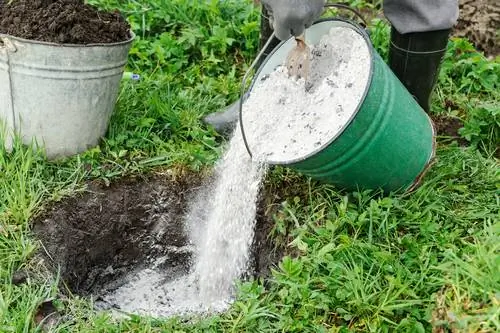
Fruit trees are happy about a good portion of ash
Tip
Basically, you can also fertilize potatoes with ash. However, caution is advised because ash fertilization promotes potato scab.
In the forest
If you own your own forest, you will appreciate the high lime content of wood ash. The majority of all German forest soils are too acidic. In a well-dosed concentration, wood ash can help improve the soil in the long term. As a result, the trees can have deeper roots, which increases their stability.
Advantages of ash fertilization:
- Extending the growing season for deciduous trees
- reduced needle drop in conifers
- increased fine root formation in the topsoil
Problems caused by ash fertilization
If ash is spread in excessive concentrations or in unfavorable weather, negative consequences can occur. These affect both soil life and plants. Incorrect fertilization can cause great damage, so you should use ash in low concentrations.
Plant damage
The high calcium content, which is available in its most aggressive form as quicklime, ensures that the soil is limed. This highly alkaline quicklime can cause leaf burns if residue is left on plants. In agriculture, calcium oxide is only distributed on bare areas that have a loamy to clayey subsoil.
Wonderbag
Another problem is the often unknown composition of the various substances in wood ash. The amount of minerals can vary greatly, as can the heavy metal content. Without precise analysis of the ash, fertilization tailored to the soil is not possible. You run the risk that the earth will be enriched with toxic substances rather than improved.
Soil damage
If quicklime is spread on light sandy soils, it can cause massive damage to soil life due to its low buffering capacity. Unsolidified wood ash dissolves particularly quickly if precipitation occurs after application. This can change the soil chemistry so that the plants growing there can no longer absorb nutrients in the short term. Their growth stagnates and sensitive plants can die. In order to reduce the solubility and to better control the changes in the pH value in the soil, the ash should be pelleted before application.
Tip
Let wood ash swell in water so that the fine-grained particles become saturated. Then place the pot on the stove and wait until clumps of ash have formed. These dissolve more slowly.
Have ash tested
If you want to be on the safe side, you can have your ashes analyzed in a laboratory. There are quantitative tests that test the ash for ten to twelve common heavy metals. Ten grams of wood ash is enough for a precise analysis.
If you burn different types of trees, you can send in the ashes as a mixed sample. However, it is not possible to assign the ingredients to the respective ash. If you send in multiple samples, you must expect higher costs. Depending on the laboratory, a test costs between 100 and 150 euros.
Frequently asked questions
Is ash suitable for plants that prefer acidic soil?
Ash increases the pH value of the soil and should only be used for plants that prefer calcareous soils. Hydrangeas, ferns, rhododendrons or peonies like a rather acidic humus soil, which is why ash is not suitable as fertilizer. You can fertilize these plants with coffee grounds instead.
How do I fertilize with ash?
Choose a day with no wind so that the dusty ash does not spread throughout the garden. To be on the safe side, you can moisten the ashes a little. The high pH can damage the skin, so you should wear gloves. After application, the soil is watered. Ash should never be mixed with fertilizers containing ammonium such as manure or manure, as gaseous ammonia can form. Also avoid mixing ash with phosphate. This can result in the development of calcium phosphates that are poorly soluble and not available to plants.
How much ash should I use for fertilizing?
For liming and soil improvement, you can fertilize soil with ash every three to four years. For heavy soils with a pH of 4.0, 200 to 400 grams per square meter are sufficient. For less acidic soils, reduce the amount to 100 to 200 grams. Light soils can quickly become overlimed and should therefore not be fertilized with ash. Ground eggshells are sufficient here.
Can I put ash in the compost?
Many microorganisms become more active at a high pH value. Adding ash can accelerate the decomposition processes on the compost, especially if the compost is acidic. However, you should only sprinkle the ash on the compost in small quantities to avoid over-limescale. If you are unsure of the source of the wood ash, you should dispose of it with household waste due to possible contamination.

